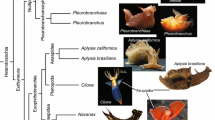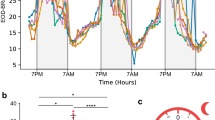Summary
-
1.
Intact, freely-behaving Aplysia californica were monitored continuously for 24 h via time-lapse video and in vivo extracellular electrophysiological recording during 24 h exposure to both ambient normoxia (6.1—6.9 ppM dissolved O2) and hypoxia (1.2–2.7 ppM dissolved O2) followed by 1–2 h of aquarium reoxygenation.
-
2.
In ambient normoxia, the stereotyped behavior known as respiratory pumping (RP) was found to spontaneously occur in several forms other than the solitary behavioral response previously described.
-
3.
The most extreme variant of the new forms of RP was that of the RP seizure which was a series of RP responses (20–60) that occurred over a 30–90 min period and in a pattern characterized by a progressively greater inter-response interval. RP seizures occurred at frequencies ranging from 0–3 times per 24 h.
-
4.
The time-course of RP seizure inter-response intervals was stereotyped across animals while seizure duration and the number of RP responses within a seizure were more similar for a given animal than across animals.
-
5.
The other forms of RP included double and triple RP responses and abbreviated RP seizures. One instance of a double RP seizure was recorded.
-
6.
Prolonged exposure to ambient hypoxia depressed all forms of RP.
-
7.
Aquarium reoxygenation returned RP activity levels to near that prior to hypoxia exposure; seizure rate was above that occurring in ambient normoxia.
-
8.
Potential physiological ramifications of RP seizures are discussed along with a possible mechanism to account for the repertoire of naturally-occurring RP behaviors.
Similar content being viewed by others
Abbreviations
- RP :
-
Respiratory pumping
References
Bayne BL (1971) Oxygen consumption by three species of lamellibranch molluscs in declining ambient oxygen tension. Comp Biochem Physiol 40A:955–970
Bayne BL (1973a) Physiological changes in Mytilus edulis L. induced by temperature and nutritive stress. J Mar Biol Assoc UK 53:39–58
Bayne BL (1973b) The responses of three species of bivalve molluscs to declining oxygen tension at reduced salinity. Comp Biochem Physiol 45A:793–806
Byrne JH (1981) Comparative aspects of neural circuits for inking behavior and gill withdrawal in Aplysia californica. J Neurophysiol 45:98–106
Byrne JH (1982) Analysis of synaptic depression contributing to habituation of gill-withdrawal reflex in Aplysia californica. J Neurophysiol 48:431–438
Byrne JH (1983) Identification and initial characterization of a cluster of command and pattern-generating neurons underlying respiratory pumping in Aplysia californica. J Neurophysiol 49:491–508
Byrne JH, Koester J (1978) Respiratory pumping: neuronal control of a centrally commanded behavior in Aplysia. Brain Res 143:87–105
Carew TJ, Pinsker HM, Kandel ER (1972) Long-term habituation of a defensive withdrawal reflex in Aplysia. Science 175:451–454
Carew TJ, Walters ET, Kandel ER (1981) Classical conditioning in a simple withdrawal reflex in Aplysia californica. J Neurosci 1:1426–1437
Castellucci VF, Carew TJ, Kandel ER (1978) Cellular analysis of long term habituation of the gill withdrawal reflex of Aplysia californica. Science 20:1306–1308
Castellucci VF, Kandel ER (1974) A quantal analysis of the synaptic depression underlying habituation of the gill withdrawal reflex in Aplysia. Proc Natl Acad Sci USA 71:5004–5008
Castellucci VF, Kandel ER (1976) Presynaptic facilitation as a mechanism for behavioral sensitization in Aplysia. Science 194:1176–1178
Castellucci V, Pinsker H, Kupfermann I, Kandel ER (1970) Neuronal mechanisms of habituation and distribution of the gill-withdrawal reflex in Aplysia. Science 167:1745–1748
Chalazonitis N (1974) Simultaneous recordings of pH, pCO2, and neuronal activity during hypercapnic transients (identifiable neurons of Aplysia). In: Nahas G, Shaefer KE (eds) Carbon dioxide and metabolic regulations. Springer, Berlin Heidelberg New York, pp 63–80
Chalazonitis N, Nahas G (1965) Small pCO2 changes and neuronal synaptic activation. Nature 205:1016–1017
Cobbs JS, Pinsker HM (1978) In vivo responses of paired giant mechanoreceptor neurons in Aplysia abdominal ganglion. J Neurobiol 9:121–141
Cohen J, Cohen P (1975) Applied multiple regression/correlation analysis for the behavioral sciences. John Wiley and Sons, New York
Coyer PE, Halsey HH, Strong ER (1981) Reversible and irreversible effects of pO2 alterations on two groups of Aplysia neurons. Comp Biochem Physiol 68A:579–587
Coyer PE (1983) Responses of regularly-firing Aplysia R3–R13 neurons to normoxia and hypoxia. J Exp Biol 107:1–8
Croll RP (1985) Sensory control of respiratory pumping in Aplysia californica. J Exp Biol 117:15–27
de Fur PL, Lukowiak K (1982) Some in vivo and in vitro characteristics of Aplysia californica haemolymph. J Exp Biol 101:347–351
Dieringer N, Koester J, Weiss KR (1978) Adaptive changes in heart rate of Aplysia californica. J Comp Physiol 123:11–21
Eberly L (1981) Quantitative analysis of a motorneuron population in intact Aplysia: a novel neuroethological approach. PhD Thesis, University of Texas Medical Branch, Galveston, Texas
Eberly L, Kanz J, Taylor C, Pinsker H (1981) Environmental modulation of a central pattern generator in freely behaving Aplysia. Behav Neural Biol 32:21–34
Eberly L, Lasseter M, Pinsker H (1979) Phase response curves and entrainment of the Interneuron II oscillator in intact behaving Aplysia. Soc Neurosci Abstr:795
Famme P (1980) Oxygen-dependence of the respiration by the mussel Mytilus edulis L. as a function of size. Comp Biochem Physiol 67A:171–174
Famme P, Kofoed LH (1980) The ventilatory current and ctenidial function related to oxygen uptake in declining oxygen tension by the mussel Mytilus edulis L. Comp Biochem Physiol 66A:161–172
Ghiretti F (1966) Respiration. In: Wilbur KM, Yonge CM (eds) Physiology of Mollusca. Academic Press, New York, pp 175–208
Hamilton PV, Ambrose HW III (1975) Swimming and orientation in Aplysia brasiliana (Mollusca: Gastropoda). Mar Behav Physiol 3:131–143
Hening W, Carew T, Kandel E (1976) Interganglionic integration of different behavioral components of a centrally commanded behavior. Soc Neurosci Abstr:485
Hinde RA (1982) Ethology. Oxford University Press, New York
Houlihan DF, Innes AJ, Wells MJ, Wells J (1982) Oxygen consumption and blood gases of Octopus vulgaris in normoxic and hypoxic conditions. J Comp Physiol 148:35–40
Johansen K, Lenfant C (1966) Gas exchange in the cephalopod Octopus dofleini. Am J Physiol 210:910–918
Kandel ER (1976) Cellular basis of behavior. Freeman, San Francisco
Kandel ER (1979) Behavioral biology of Aplysia. WH Freeman, San Francisco
Kanz JE, Eberly LB, Cobbs JS, Pinsker HM (1979) Neuronal correlates of siphon withdrawal in freely behaving Aplysia. J Neurophysiol 42:1538–1556
Kinne O (1966) Respiratory adaptations of marine invertebrates in different salinities. Neth J Sea Res 3:222–244
Koester J (1983) Respiratory pumping in Aplysia is mediated by two coupled clusters of interneurons. Soc Neurosci Abstr 158:13
Koester J, Dieringer N, Mandelbaum DE (1979) Cellular neuronal control of molluscan heart. Am Zool 19:103–116
Koester J, Mayeri E, Liebeswar G, Kandel ER (1973) Cellular regulation of homeostasis, neuronal control of the circulation in Aplysia. Fed Proc 32:2179–2187
Koester J, Mayeri E, Liebeswar G, Kandel ER (1974) Neural control of circulation in Aplysia. II. Interneurons. J Neurophysiol 37:476–496
Kupfermann I (1974) Feeding behavior in Aplysia: A simple system for the study of motivation. Behav Biol 10:1–26
Kupfermann I, Carew TJ (1974) Behavior patterns of Aplysia californica in its natural environment. Behav Biol 12:317–337
Kupfermann I, Kandel ER (1969) Neuronal controls of a behavioral response mediated by the abdominal ganglion of Aplysia. Science 164:847–850
Kupfermann I, Carew T, Kandel ER (1974) Local, reflex and central commands controlling gill and siphon movements in Aplysia. J Neurophysiol 37:996–1019
Levy M, Achituv Y, Susswein AJ (1989) Relationship between respiratory pumping and oxygen consumption in Aplysia depilans and Aplysia fasciata. J Exp Biol 141:389–405
Loveland RE, Chu DSK (1969) Respiratory movements and pumping in Mercenaria. Comp Biochem Physiol 29:173–184
Lukowiak K, Sahey C (1981) The in vitro classical conditioning of the gill withdrawal reflex in Aplysia californica. Science 212:1516–1518
Mayeri E, Koester J, Kupfermann I, Liebeswar G, Kandel ER (1974) Neural control of circulation in Aplysia. I. Motorneurons. J Neurophysiol 37:458–475
Moffett S, Wachtel H (1975) Correlation between temperature effects on behavior in Aplysia and firing patterns of identified neurons. Mar Behav Physiol 38:1–14
Peretz B (1969) Central neuron initiation of periodic gill movements. Science 166:1167–1172
Perlman AJ (1979) Central and peripheral control of the siphon withdrawal reflex in Aplysia californica. J Neurophysiol 42:510–529
Roth JD, Lukowiak K, Berry RS (1984) Long-lasting inhibition of neuron R15 of Aplysia: role of the interneuron II network. Comp Biochem Physiol 78A:83–89
Sawada M, Blankenship JE, McAdoo DJ (1981) Neural control of a molluscan blood vessel, anterior aorta of Aplysia. J Neurophysiol 46:967–986
Siegel S (1956) Nonparametric statistics for the behavioral sciences. McGraw-Hill, New York
Spotte S (1979) Seawater aquariums, the captive environment. John Wiley and Sons, New York
Waziri R, Kandel ER (1969) Organization of inhibition in abdominal ganglion of Aplysia. III. Interneurons mediating inhibition. J Neurophysiol 32:520–539
Wells MJ, Wells J (1982) Ventilatory currents in the mantle of cephalopods. J Exp Biol 99:315–330
Author information
Authors and Affiliations
Rights and permissions
About this article
Cite this article
Kanz, J.E., Quast, W.D. Respiratory pumping seizure: a newly discovered spontaneous stereotyped behavior pattern in the opisthobranch mollusc Aplysia californica . J Comp Physiol A 166, 619–627 (1990). https://doi.org/10.1007/BF00240011
Accepted:
Issue Date:
DOI: https://doi.org/10.1007/BF00240011




